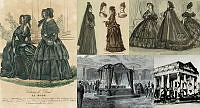Rubenstein Center Scholarship
A Resolute Myth: Debunking the Resolute Desk Panel

The Resolute Desk
White House Historical Association/White House CollectionAs historians, one part of our job is to question and investigate oft-repeated stories in history. Myths, inaccuracies, and questionable documentation abound in White House history, and historical facts can be ignored, altered, misremembered, or forgotten as time passes.
One such example is the history of the Resolute Desk—one of the most important symbols of the presidency and a priceless White House artifact. Queen Victoria gifted the desk to President Rutherford B. Hayes in 1880, and it has been used by almost every president since.1 There have been two significant modifications to the desk: the addition of a panel bearing the Presidential Coat of Arms (completed in 1945) and a base to heighten the desk (first added in 1961).2

Resolute Desk Panel, 2005.
George W. Bush Library/NARAPresident John F. Kennedy first requested the latter—but what about the former? Countless books and articles claim that President Franklin D. Roosevelt authorized the addition of a panel in 1945 to “hide his leg braces,” attributing the decision to his disability.3 The story even made an appearance in Disney’s 2007 film National Treasure: Book of Secrets, lending new prominence to the tale.4 But the reality is more complicated.
It is true that like so many of his predecessors, Roosevelt used the Resolute Desk as president. It is also true that the optics of disability played a role in Roosevelt’s presidency. In 1921, Roosevelt’s doctor diagnosed him with poliomyelitis (polio), impacting his ability to walk. For the rest of his life, Roosevelt used a wheelchair and leg braces or relied upon the arm of another and a cane to walk upright.5 Although Americans knew of his polio diagnosis, Roosevelt hid the extent of his disability during his time in office.6 According to White House Chief Usher J. B. West, “the White House staff took extraordinary precautions to conceal Mr. Roosevelt’s inability to walk” and “no photographs were permitted.”7 Two new ramps were also installed at the White House to accommodate Roosevelt’s wheelchair, and he used an elevator to move about the Residence and West Wing.8

Roosevelt sits at the Resolute Desk with his dog, Fala.
Franklin D. Roosevelt Presidential Library and Museum/NARA
Sketch by architect Eric Gugler of ramp addition to the White House.
National Park Service, Office of White House LiaisonAs a result, this story of the Resolute Desk panel somewhat fits the narrative of Roosevelt’s efforts to conceal his disability. However, there are also several inconsistencies as well.
The first is location— President Roosevelt used the Resolute Desk upstairs in his Second Floor Study (now the Yellow Oval Room). There, he met with close advisors, friends, and family, who were aware of his leg braces and wheelchair use. Meanwhile, in the Oval Office, he conducted press conferences, posed for photographs, and met with world leaders and public groups. The desk, as seen in the image below, had an open front where his legs were clearly visible.9

Roosevelt sits at his desk in the Oval Office-notice the open front.
Franklin D. Roosevelt Library/NARAThe second inconsistency is logistical. Roosevelt wore leg braces beneath his trousers, and they were hardly visible, blending into his socks.10 A panel would be unnecessary to hide them. Upon arriving at his desk, Roosevelt moved from his wheelchair to a stationary chair, evidenced in photographs of his study and Oval Office desks.11

Roosevelt used leg braces to move about in public; this pair belonged to him.
Franklin D. Roosevelt Presidential Library and MuseumFinally, the timeline is peculiar. President Roosevelt suddenly passed away in Warm Springs, Georgia, on April 12, 1945, and designs for the panel, made by architect Lorenzo Winslow, are dated to June 13, 1945—two months later.12 The addition was completed in August 1945. Thus, the design and creation of the panel took place during Harry S. Truman’s presidency, although there is no documentation about the reasoning behind this decision at the Harry S. Truman Presidential Library or the White House Office of the Curator.13
So where does the story come from? This version of events first appears in a 1962 telephone call readout with Rudolf W. Bauss, documented in the files of the White House Office of the Curator. Bauss was a model-maker and designer employed by the National Park Service; he carved the panel addition.14 Bauss said: “The President requested that a panel be placed in the desk for the following reasons: 1.) to hide the iron braces on his legs; 2.) to conceal a safe which the President wished to place just behind the panel.”15 Based upon the evidence listed above, it appears that Bauss’s recollections were inaccurate. This is not entirely surprising—nearly two decades had passed between the panel addition and the telephone call. Unfortunately, recollections are inherently flawed, as memories shift and change over time.
This error might seem like a small detail, but the persistence of this story illuminates how Americans perceive and remember President Roosevelt’s disability. As Gil Klein writes, “Most of the American myths are based on historical fact… The writers of these tales took those kernels of truth and embellished them, made them sound more romantic and uplifting than perhaps they were, and drove home a moral message designed to educate and inspire a new generation.”16

Roosevelt sits in his wheelchair, 1941.
Franklin D. Roosevelt Presidential Library and Museum/NARAIndeed, historians have considered the role that Roosevelt’s disability—and our memory of it— has played in his legacy.17 Scholar Sara Polak writes that “FDR’s disability and wheelchair came to function as… a metaphor for the nation’s ability to ‘conquer’ adversity.”18 She explains that while the public knew about Roosevelt’s wheelchair during his presidency, Americans truly came to associate him with his disability (and by extension, his wheelchair and leg braces) following his death.19
This is particularly evident in the creation of the Franklin Delano Roosevelt Memorial on the National Mall in Washington, D.C. The depiction of Roosevelt seated in a wheelchair was added after the initial dedication of the memorial; this was thanks to the lobbying of groups like the National Organization on Disability.20 This timeline aligns with that of the Resolute Desk panel myth— as Americans increasingly associated Roosevelt with his disability, stories surrounding his time in the White House did as well.

Franklin Delano Roosevelt Memorial, Washington, D.C.
National Park ServiceIn the end, even if Roosevelt had requested the panel, there is no evidence to suggest the decision was tied to his disability and President Harry S. Truman was the first president to use the newly outfitted Resolute Desk. From the famous photograph of John F. Kennedy Jr. popping out of the kneehole in 1963 to the panel’s role in popular culture, the Resolute Desk has become a recognizable symbol of the presidency and a national icon.
Many thanks to curators and archivists at the Franklin D. Roosevelt Library, the Harry S. Truman Library, and the White House Office of the Curator for their input on this article.





































